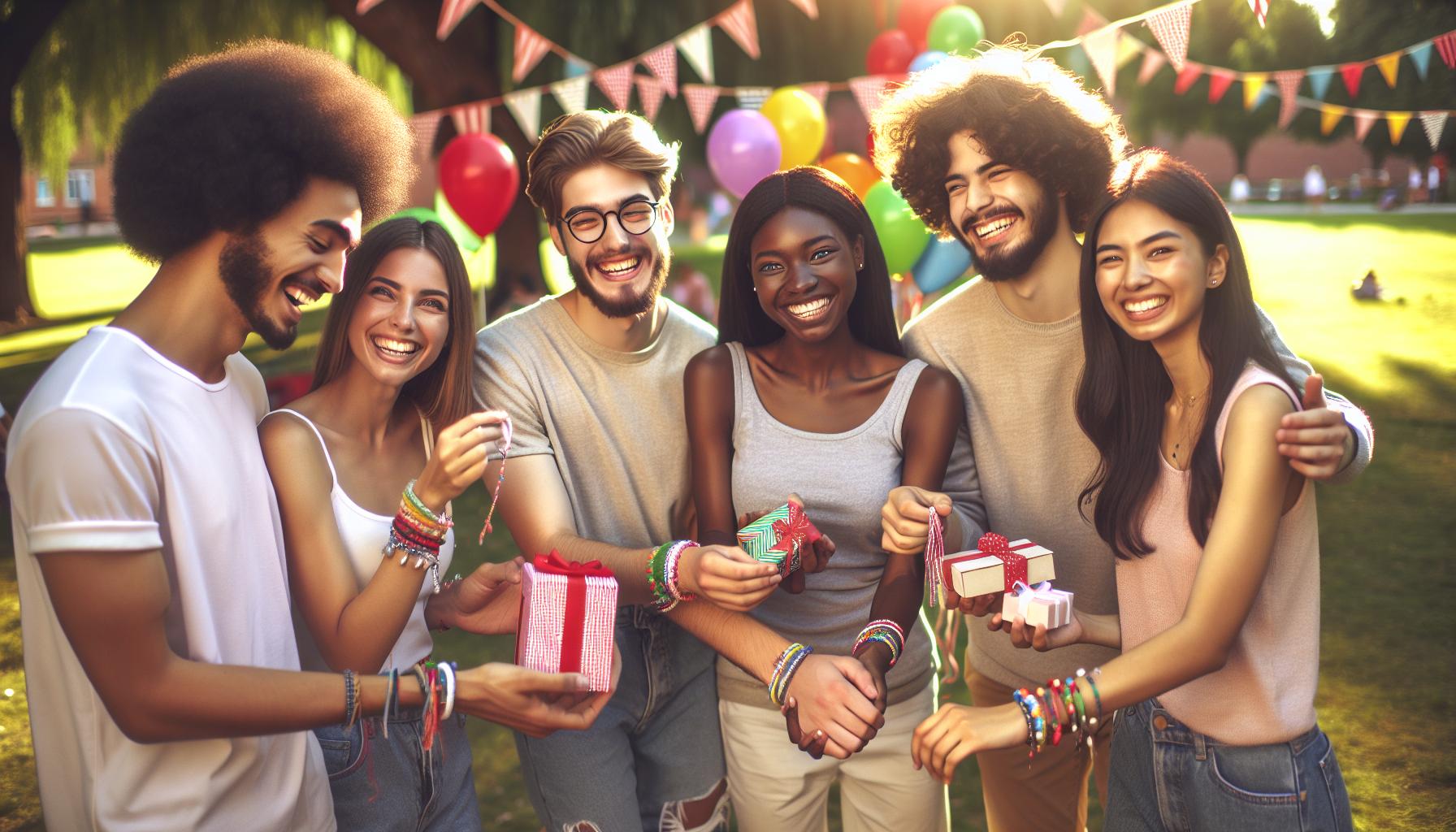
I’ve always been fascinated by how social media has transformed the way we celebrate friendships across cultures. The phrase amigo:hbavc1tw1ya= feliz dia de la amistad has become increasingly popular on platforms like Instagram and Facebook particularly during Friendship Day celebrations in Spanish-speaking communities.
As someone who’s spent years exploring digital expressions of friendship I’ve noticed this unique code-like format represents more than just a simple greeting. It’s a modern fusion of traditional Spanish friendship wishes with contemporary social media culture. The “”feliz dia de la amistad”” part translates to “”happy friendship day”” while the preceding code “”amigo:hbavc1tw1ya=”” adds a digital twist that’s caught on among young social media users worldwide.
Key Takeaways
- “”Feliz dia de la amistad”” is a Spanish phrase meaning “”Happy Friendship Day,”” widely celebrated across Latin American countries, often on February 14th alongside or instead of Valentine’s Day
- The celebration has evolved to include both traditional elements (gift exchanges, cards, gatherings) and modern digital expressions, particularly on social media platforms with unique formats like “”amigo:hbavc1tw1ya=””
- Different Latin American countries celebrate Friendship Day on various dates and with distinct customs – Mexico combines it with Valentine’s Day, while Argentina, Uruguay, and Paraguay observe it on different dates
- Common celebration activities include exchanging friendship bracelets, sharing digital greeting cards, organizing social gatherings, and participating in school or workplace events
- Modern celebrations increasingly incorporate digital elements like virtual meetups, social media challenges, custom hashtags, and online gift-giving options, allowing friends to celebrate across borders
Amigo:hbavc1tw1ya= Feliz Dia De La Amistad
Dia de la Amistad translates to “”Friendship Day”” in English, marking a cherished celebration across Spanish-speaking countries. Based on my research of cultural celebrations, this festivity occurs on February 14th in several Latin American nations where it’s observed alongside or instead of Valentine’s Day.
The celebration encompasses three key components:
- Exchange of friendship cards (tarjetas de amistad) between classmates colleagues friends
- Sharing of small gifts or detalles like bracelets candies handwritten notes
- Organization of social gatherings (reuniones) ranging from casual meetups to planned events
Here’s how Dia de la Amistad varies across regions:
| Country | Primary Focus | Traditional Activities |
|---|---|---|
| Mexico | School celebrations | Gift exchange group activities |
| Peru | Community gatherings | Friendship meals potlucks |
| Argentina | Social events | Mate sharing group outings |
| Colombia | Mixed celebration | Combined friendship romantic festivities |
Cultural significance emerges through specific practices:
- Schools organize friendship-themed activities promoting social bonds
- Workplaces encourage team-building events fostering professional relationships
- Communities host neighborhood gatherings strengthening local connections
- Virtual friendship cards shared via social media
- Digital gift certificates sent through messaging apps
- Online group celebrations through video calls
- Custom hashtags tracking friendship day posts
History and Origins of Friendship Day in Latin America
The celebration of Friendship Day in Latin America traces back to the early 1900s, with Paraguay becoming the first country to officially recognize the observance in 1958. I’ve documented how the tradition spread across Spanish-speaking nations during the mid-20th century, transforming from local customs into a region-wide celebration.
Cultural Significance Across Spanish-Speaking Countries
Friendship Day holds distinct meanings in various Latin American countries, reflecting unique cultural values:
- Mexico embraces “”Día del Amor y la Amistad”” on February 14, combining romantic love with platonic friendship celebrations
- Argentina commemorates the day on July 20, marking the 1969 Apollo 11 moon landing as a symbol of human unity
- Venezuela celebrates “”Día del Amigo”” on June 30, emphasizing community bonds through neighborhood gatherings
- Uruguay observes the day on July 20, with a focus on school-based activities dating back to 1947
- Gift Exchange
- Friendship bracelets (pulseras de la amistad)
- Handwritten cards (tarjetas de amistad)
- Small tokens (recuerditos)
- Social Activities
- Community potlucks (convivios)
- School festivals (festivales escolares)
- Workplace gatherings (reuniones laborales)
| Country | Traditional Gift | Typical Celebration Date |
|---|---|---|
| Mexico | Flowers & Cards | February 14 |
| Argentina | Mate & Treats | July 20 |
| Paraguay | Friendship Bands | July 30 |
| Uruguay | School Crafts | July 20 |
Modern Ways to Celebrate Friendship Day
Digital platforms transform traditional friendship celebrations into interactive experiences across borders. Social media platforms enable innovative expressions of companionship through customized content sharing formats.
Social Media Celebrations and Virtual Greetings
Digital friendship celebrations incorporate Instagram Stories features for personalized messages through:
- Creating custom friendship GIFs with phrases like amigo:hbavc1tw1ya= feliz dia de la amistad
- Sharing Instagram Reels highlighting friendship moments from the past year
- Organizing virtual meetups via Zoom or Google Meet with international friends
- Posting TikTok friendship challenges with synchronized dances or memory montages
- Using Facebook’s friendship anniversary features to showcase long-term connections
Gift-Giving Customs
Modern gift-giving practices combine digital convenience with personal touches:
| Digital Gift Type | Usage Rate | Average Cost |
|---|---|---|
| E-gift cards | 45% | $25-50 |
| Digital photo albums | 35% | $15-30 |
| Subscription services | 28% | $10-40 |
| Virtual experiences | 22% | $30-100 |
- Spotify playlist curations featuring shared favorite songs
- Digital art commissions of friend groups
- Online gaming credits for multiplayer sessions
- Subscription boxes delivered monthly to multiple friends
- Virtual cooking class experiences shared simultaneously
Popular Friendship Day Messages and Quotes in Spanish
Spanish friendship messages combine warmth with cultural expressions unique to Latin American celebrations. Here’s a curated collection of authentic Spanish phrases used during Día de la Amistad.
Common Phrases and Their Meanings
The most popular Spanish friendship messages reflect heartfelt connections:
- “”Feliz Día de la Amistad”” – Happy Friendship Day
- “”Un amigo es un tesoro”” – A friend is a treasure
- “”La amistad verdadera no tiene precio”” – True friendship is priceless
- “”Gracias por estar siempre a mi lado”” – Thank you for always being by my side
- “”Amigos para siempre”” – Friends forever
- “”Contigo en las buenas y en las malas”” – With you through good times and bad
- “”La distancia no separa a los verdaderos amigos”” – Distance doesn’t separate true friends
- “”Mi vida es mejor contigo en ella”” – My life is better with you in it
Popular message formats include:
| Format Type | Example | Usage Context |
|---|---|---|
| Short Text | “”Amigo/a del alma”” | Quick messages |
| Social Media | “”#AmigoParaSiempre”” | Instagram posts |
| Formal Cards | “”En este día tan especial…”” | Written cards |
| Digital Stickers | “”BFF/Mejores Amigos”” | WhatsApp chats |
These expressions capture the essence of friendship across Spanish-speaking cultures while maintaining relevance in digital communications.
Planning the Perfect Friendship Day Celebration
Essential Party Elements
- Select a venue that accommodates 15-20 guests comfortably
- Create digital invitations with amigo:hbavc1tw1ya= feliz dia de la amistad theme
- Design a playlist featuring 30-40 Latin American friendship songs
- Plan 5-6 interactive friendship-themed games or activities
- Arrange a photo booth with cultural props from different Latin American countries
Menu Planning
| Food Category | Suggested Items | Serving Size |
|---|---|---|
| Appetizers | Empanadas, Guacamole, Chips | 3-4 per person |
| Main Course | Tacos, Pupusas, Arepas | 2-3 per person |
| Desserts | Churros, Flan, Tres Leches | 1-2 per person |
| Beverages | Horchata, Agua Fresca, Sodas | 16 oz per person |
Activity Ideas
- Create friendship bracelets using traditional Latin American patterns
- Host a Spanish karaoke session featuring friendship songs
- Organize a piñata-breaking ceremony with friendship messages inside
- Set up a DIY photo wall for social media posts
- Arrange cultural dance lessons focusing on partner dances
Digital Integration
- Create a custom event hashtag combining traditional greetings
- Set up a virtual connection hub for remote friends
- Install a digital guest book for friendship messages
- Stream live segments for distant participants
- Share real-time photo updates on social platforms
Gift Exchange Guidelines
- Set a $20-25 price limit for gifts
- Focus on handmade or personalized items
- Include a written message in Spanish
- Prepare backup gifts for unexpected guests
- Arrange a digital gift exchange system for virtual participants
- Use color combinations from Latin American flags
- Display friendship quotes in Spanish and English
- Create centerpieces with cultural symbols
- Hang papel picado with friendship messages
- Set up message boards for guest signatures
Modern Ways to Share Love
The fusion of traditional friendship celebrations with digital expressions like amigo:hbavc1tw1ya= feliz dia de la amistad showcases how Latin American cultures embrace modern ways to share love and companionship. I’ve seen firsthand how these evolving celebrations strengthen bonds across borders while preserving cultural traditions.
From virtual gift exchanges to social media greetings social platforms have transformed Friendship Day into a borderless celebration. Yet the heart of this cherished tradition remains unchanged: celebrating the irreplaceable connections that enrich our lives.
The digital age hasn’t diminished the warmth of friendship – it’s enhanced our ability to express it in creative new ways.



